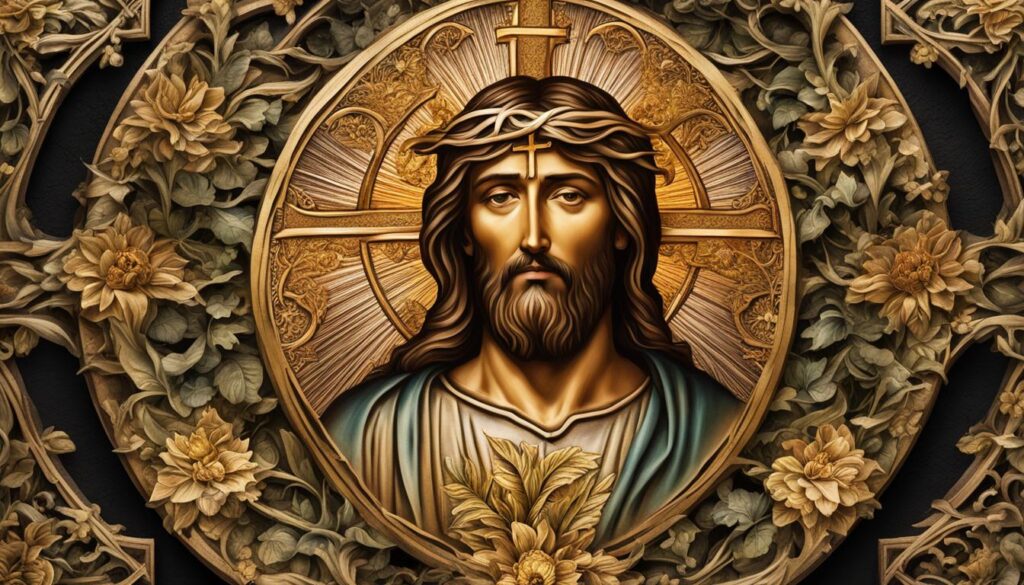Tattoos have long been a subject of debate in Christianity, with some questioning their place in religious beliefs. However, when delving into biblical references and historical evidence, it becomes apparent that there may be clues suggesting that Jesus, the central figure of the Christian faith, Did Jesus Have a Tattoo?.
In Leviticus 19:28, a verse warns against making cuttings in the flesh or tattooing marks, which some interpret as a prohibition of tattoos. Yet, the interpretation and application of this verse to modern-day tattoos are open to personal understanding and interpretation.
One intriguing historical clue is the discovery of a 1,300-year-old body in Sudan, which featured a tattoo of the Greek letters Chi and Rho—a symbol commonly associated with Christ during that era. This finding challenges the previously held belief that only women had tattoos in medieval Nubia and raises questions about the relationship between tattoos and expressions of faith.
While the exploration of biblical clues and historical evidence suggests the possibility of Jesus having a tattoo, it ultimately comes down to individual interpretation and personal beliefs.
Key Takeaways:
- There are biblical references and historical clues that suggest Jesus may have had a tattoo, but interpretation and personal beliefs play a significant role.
- Historical views on tattoos in Christianity have varied throughout different time periods and cultures within the faith.
- Ancient tattoos and biblical references suggest the symbolic significance of tattoos in religious contexts.
- The discovery of a rare tattoo on a 1,300-year-old body challenges previous assumptions about medieval Nubian tattoo practices.
- Acceptance of tattoos among Christians depends on personal beliefs and interpretations of biblical teachings, with an emphasis on living out one’s faith through love and kindness.
The Historical View on Tattoos in Christianity
The historical view on tattoos in Christianity has been diverse and has evolved over different time periods. While tattoos were associated with pagan rituals and generally discouraged in the early centuries, there were contrasting opinions and practices among early church fathers. The perception of tattoos in Christianity can vary across different cultures and regions, as indigenous tattoo practices have influenced religious tattoo traditions.
In the early centuries of Christianity, tattoos were often viewed as connected to pagan rituals and were discouraged. One example of this can be seen in the 787 Council of Northumberland in England, where religious and profane tattoos were distinguished. The native Britons, who practiced tattooing for pagan rituals, were criticized for their tattoo practices.
However, there were also differing views on tattoos within Christianity. For instance, Basil the Great, a prominent figure in the fourth century, condemned tattooing as a heathen practice. On the other hand, the Coptic Church in Egypt had a long-standing tradition of marking themselves with tattoos since the sixth or seventh century. These markings were often religious in nature and symbolized their faith.
This diversity of viewpoints within Christianity illustrates the complex and evolving nature of the historical perspective on tattoos. It highlights how cultural and regional influences, as well as indigenous tattoo practices, have shaped the perception of tattoos in the context of religious beliefs. It’s important to understand the historical view on tattoos in Christianity to gain a deeper understanding of the subject and its significance.
| Historical View on Tattoos in Christianity | Early Church Fathers and Tattoos | Religious Tattoos in Ancient Times | Indigenous Tattoo Practices and Christianity |
|---|---|---|---|
| Tattoos associated with pagan rituals | Contrasting opinions and practices | Diverse interpretations and symbolism | Regional and cultural influences |
| Discouragement of tattoos in early centuries | Basil the Great’s condemnation of tattooing | Coptic Church’s tradition of religious markings | Incorporation of indigenous tattoo practices |
| Criticism of native Britons’ tattoo rituals | Evolution of viewpoints over time | Interpretation of tattoos as signs of faith | Shaping of religious tattoo traditions |
Ancient Tattoos and Biblical References
Ancient times witnessed the existence of tattoos in various cultures, often intertwined with religious and spiritual beliefs. In particular, there are intriguing biblical references to tattoos that offer insights into their symbolic significance.
In the book of Revelation, there is a mention of Jesus having a name written on his garment and thigh. This reference has sparked interpretations suggesting that this inscription could be seen as a form of tattooing, indicating a profound connection to Christ. Similarly, in the Old Testament, the prophet Isaiah alludes to God engraving the names of his people on the palms of his hands. This act of marking, or even tattooing, serves as a powerful symbol of identity and belonging.
It’s worth noting that the exact word for “tattoo” in the Bible is not explicitly defined. Consequently, the translation and interpretation of these biblical references may not fully encapsulate the original intention behind them. However, they offer intriguing glimpses into the significance attributed to tattoos or markings in ancient religious texts.
The Symbolism of Tattoos in Religious Texts
Throughout history, tattoos have often held profound symbolic importance. In religious texts, they have been associated with ritualistic practices, spiritual devotion, and acts of worship. Tattoos can serve as visible expressions of one’s faith, a personal and permanent testament to religious beliefs.
By adorning themselves with tattoos, individuals may seek to embody and outwardly manifest their spiritual commitments. These markings can denote membership in a specific religious community, signify devotion to a particular deity or religious tradition, or symbolize acts of transformation and purification.
While the biblical references to tattoos offer intriguing clues, it’s essential to consider them within their historical context and the cultural framework of the time. Understanding the symbolism of tattoos in religious texts requires an appreciation for the multifaceted interpretations that arise from diverse perspectives and personal beliefs.
Biblical References to Tattoos
The biblical references to tattoos provide a fascinating glimpse into the historical and cultural perspectives on body modification. However, it’s important to approach these references with an open mind and recognize the potential for nuanced interpretations.
Tattoos in religious texts can be seen as visual representations of faith, serving as reminders of divine presence, devotion, and personal transformation. They carry a symbolic weight that transcends the physical realm, offering a tangible link to one’s spiritual journey.
While the specific word for “tattoo” may not be explicitly mentioned, the essence of marking oneself as a sign of faith can be found in these biblical passages. It is through personal reflection and contemplation that individuals can discern the deeper meanings behind these references and their relevance to their own spiritual beliefs.
In conclusion, ancient tattoos and biblical references provide a captivating insight into the historical and symbolic significance of body art in religious contexts. While interpretations may vary, the exploration of these connections offers valuable avenues for understanding the intersection of faith, spirituality, and the human desire for physical expression.
The Discovery of a Medieval Tattoo
https://www.youtube.com/watch?v=3zyb2Otqljs
In recent years, a significant discovery was made in Sudan that sheds light on the ancient practice of tattooing. Archaeologists uncovered the remains of a 1,300-year-old body with a rare and intriguing tattoo. This finding challenges the prevailing belief that tattoos were primarily restricted to women in medieval Nubia.
The tattoo, located on the man’s right foot, prominently features the Greek letters Chi and Rho. These letters form an abbreviation for the title “Christ” and were commonly associated with Christian symbolism during that era. The presence of this tattoo on a male body raises questions about the significance of tattoos in religious contexts and challenges traditional notions of gender-specific tattooing.
It is believed that the tattoo held personal significance to the individual rather than functioning as a public display. Some experts speculate that the tattoo may have served as a marker of a spiritual journey or represented a connection to Christ’s crucifixion. Regardless of its specific meaning, the discovery of this medieval tattoo showcases the historical and religious importance of tattoos in ancient Nubia.
This remarkable find not only provides a glimpse into the ancient art of tattooing but also offers valuable insights into the cultural and religious practices of the time. By examining the significance of tattoos in ancient Nubia, researchers can better understand the complexities of religious symbolisms and their expressions through body art.
Reflecting on Tattoos and Christianity
The topic of tattoos in Christianity is a complex and diverse subject. While some biblical verses can be interpreted as warning against tattoos, others suggest that tattoos may hold symbolic significance. Ultimately, the acceptance of tattoos among Christians depends on personal beliefs and interpretations of biblical teachings.
It is important to consider the cultural and historical context of tattooing practices and to prioritize love and kindness in our actions towards others. Christians should focus on living out their faith in a way that reflects Jesus’ love, rather than solely on external expressions such as tattoos.
By emphasizing love and kindness, Christians can demonstrate their faith and make a positive impact on those around them. Rather than judging or shaming others based on their personal choices, Christians are called to love and accept one another. This means respecting differing beliefs and practicing tolerance towards those with tattoos, understanding that personal convictions can vary.
Ultimately, Christians should prioritize the core teachings of the faith, such as love, compassion, and forgiveness, over external appearances. It is up to each individual to discern their own convictions and make informed decisions based on their understanding of biblical teachings and personal faith.
FAQ
What does the Bible say about tattoos?
Did Jesus have a tattoo?
How have views on tattoos in Christianity evolved throughout history?
What is the significance of tattoos in ancient cultures?
Are there any historical discoveries related to tattoos in Christianity?
How should Christians approach the topic of tattoos?
Forhad
Forhad's writing is not just about the artistry of tattoos or the latest trends in the industry; it's an exploration of the deep-rooted connections people have with their tattoos, reflecting personal narratives, cultural histories, and moments of transformation. Through a mix of in-depth features, personal narratives, and insightful analyses, he sheds light on the multifaceted nature of tattooing, revealing the emotional and cultural layers that lie beneath the surface.











